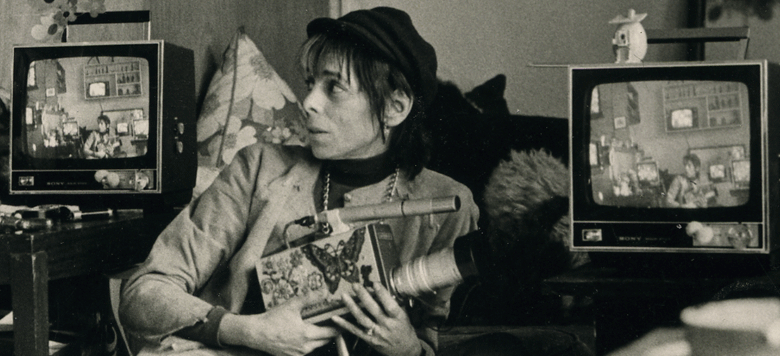Film: Portrait of Jason (1967)
Director: Shirley Clarke (below)
Author: Brian Masefield
Whether or not you’ll jive with the classic doc Portrait of Jason may boil down to a question of etiquette. When a party guest drinks a bit too much, and smokes a bit too much, does one blame the guest or the host? Yes, the guest is the one carrying on, but the host has allowed it to continue.
Made in 1966, Portrait of Jason is more a series of clips than a complete film, documentary or otherwise. Jason Holliday (featured image), the film’s subject, is a marvel of his time. Black, gay, and fabulous, Holliday fancies himself a charmer. He’s a professional one, after all. Jason Holliday (not his real name) is a hustler, in the truest form of the word. He’s invited to the apartment of director Shirley Clarke (below) to talk about his life and times, and to share some fascinating stories. Lots of them.
I’ve just provided more setup than the filmmakers ever did. There are no title cards, narration, nor analysis in the film. There’s no introduction, no director credit, zip. It begins with a long, slow fade-in to Jason’s face. In fact, Jason Holliday is the only person who will appear on screen in the film’s 107 minutes.
Portrait of Jason certainly starts out promisingly enough. Holliday has charisma to spare. He’s a flashy dresser, a smooth talker, and he possesses an infectious laugh (more on that laugh later). It is no wonder Clarke chose him to be the subject of an entire film. When the film kicks off, Holliday is ready to go, and loaded with anecdotes, songs, and memorable quotes.
“I’ve spent so much of my life being sexy that I haven’t gotten anything else done,” he says at one point, and continues to say he’s slept with everyone from “Maine to Mexico.” For all of his sassy talk, Holliday never sounds salacious. The man is just having a really good time.
The most appealing element of Portrait of Jason is how fresh it still feels. Although it’s 1966, nothing feels dated. Holliday’s story of watching drag queens flirting with police officers is said with such nonchalance, that viewers may forget it will be another twenty-three years before Paris is Burning illuminates movie theaters. Holliday even demonstrates ‘the snap’ the drag queens did back then (you know the one: right hand moves from your left side to the right, with a snap), and it’s nice to see that our community still honors that snap, and that it’s not only drag queen exclusive. Holliday’s cadence is filled with long pauses, fast bursts of introspection, and streams of consciousness that are reminiscent of the current storytelling brilliance of Justin Vivian Bond. And, since he’s the only animate object on screen, we hang on his every word.
The documentary proudly chugs along in bits, but the bits eventually get shorter and more random as the movie continues. It also goes in and out of focus, has audio trouble, and, at one point, the filmmakers run out of film. All of these technical challenges are left intact, so to speak, which I’m not convinced was director Clarke’s best idea. A good way to kill an intimate portrait is to interrupt the conversation.
These left-in glitches aside, the film manages to become a chore anyway. Holliday is shown drinking and smoking pot throughout the film, and his behavior follows suit. More stories follow, but his speech gets slurry, and his memory fails him. The man of the hour, once engaging and funny, is now obnoxious and a little sad. The laugh we once found spirited, now hangs in the air like a balloon on the ceiling no one can reach. The party’s over, but Holliday doesn’t quite get it. Neither does Clarke, who insists on asking even more personal questions, which, of course, Holliday blindly attempts to answer. Like the worst of party hosts, Clarke eggs on a guest who won’t leave, when you wish she’d calm him down instead. Something feels amiss.
“Maybe we’re not intellectual enough,” a close friend of mine suggested after we saw the film at BAM (last week).
Meh. Getting the subject of your film comfortable, drunk, stoned, and encouraging him to provide more candid responses, is anything but intellectual.
“It’s a funny feeling, having a picture made about you,” Holliday says at one point. “I feel sort of grand sitting here carrying on. People are going be digging you, or I’ll be criticized. I’ll be loved or hated. What difference does it make?”
In this modern world of reality television, where ‘stars’ sit and speak directly to cameras, we’re not privy to their respective directors’ prompts. In Portrait, you can hear the prompts (though faintly), and sometimes, it feels manipulative. Not sure if the badgering was to get more information out of Holliday or to simply humiliate him.
Regardless, it doesn’t work. It doesn’t work as journalism. It doesn’t work as art. If you have the opportunity to see Portrait of Jason (in limited release), be sure not to be the last one to leave the party.
Follow Brian Masefield on Twitter: @BrianMasefield
Image of Shirley Clarke originally seen on projectshirley.com
Image of Jason Holliday originally seen on ca.blouinartinfo.com

